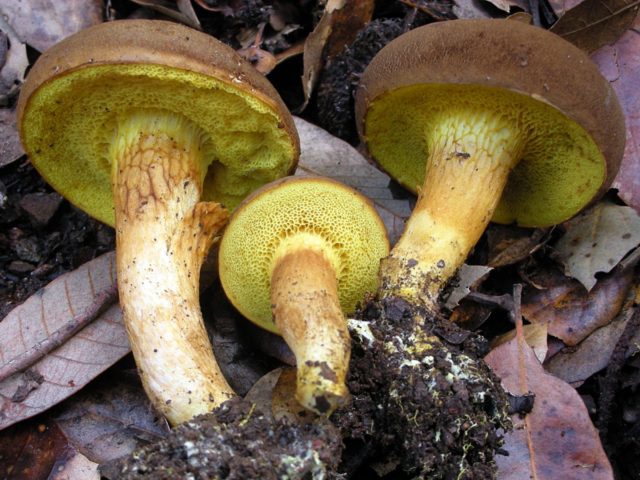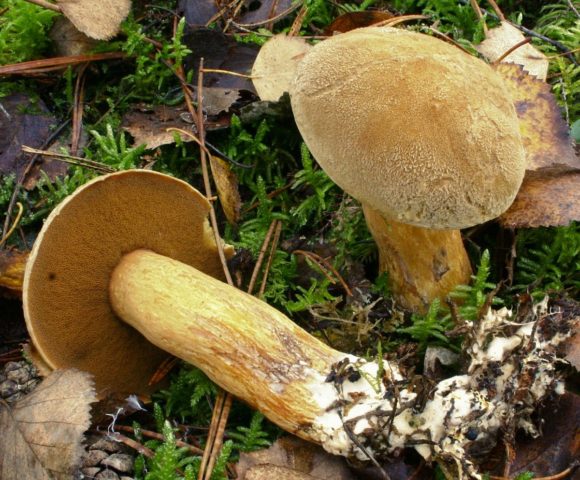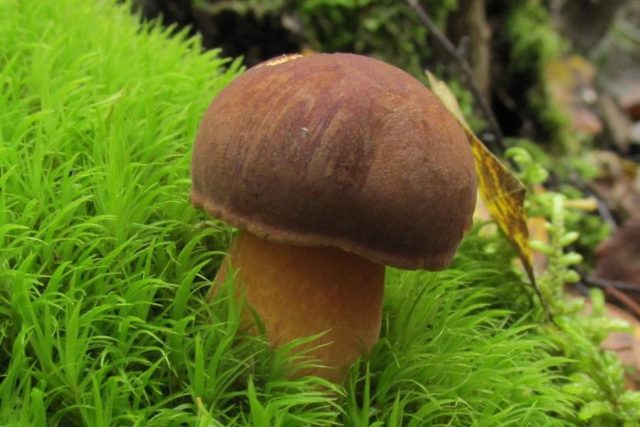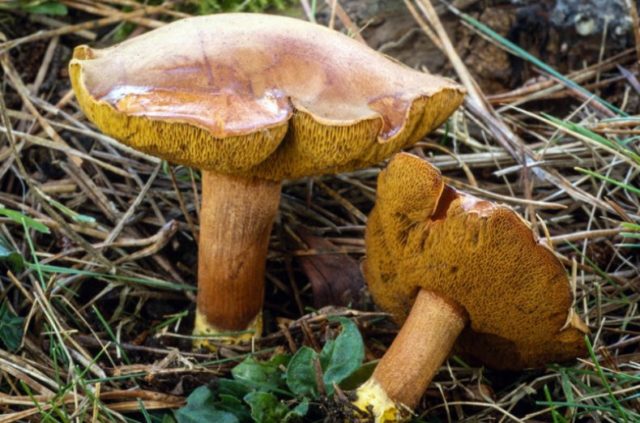Content
Green moss can be found everywhere and is highly regarded by experienced mushroom pickers for its good taste. It is widely used in cooking. This tubular representative of the Boletov family prefers to settle on moss-covered soil.
What green mushrooms look like
Green moss, or golden brown, belongs to the Borovik family. It has an olive-brown or yellow-brown fleshy cap with a velvety convex surface. As the mushroom matures, it acquires a lighter shade. The size reaches 15 cm in diameter. The tubular layer is adherent on the inner side, slightly descending to the pedicle. In young specimens it is yellow, in older specimens it is greenish, with large uneven pores that turn blue when pressed. The dense, curved leg tapering downwards grows up to 12 cm in height and 2 cm in diameter. Loose, dense pulp has a light yellow tint, turns blue on the cut. According to the description and photo, green mushrooms can be easily distinguished from other mushrooms by their feature - to emit a pleasant aroma of dried fruits when they are broken.
More details of this type are presented by the video:
Where do green mushrooms grow?
This species grows everywhere in coniferous, deciduous and mixed forests. You can meet mushrooms in the western part of Russia, but green mosshogs are found in large quantities in the Urals, the Far East and Siberia. They grow in bright places - along the sides of country roads, paths or ditches, as well as on forest edges. Rotten wood and ant heaps are their favorite spots. Rarely can a variety be found in groups: these mushrooms are "lonely". They bear fruit from the beginning of summer until the end of October.
Green flywheel is edible or not
The green flywheel is an edible species that is categorized as Category 2, indicating that it can eat both hats and legs. They are not only tasty, but also beneficial to human health.
Mushroom taste
You can cook nutritious meals with green mushrooms throughout the season. In winter, they use dried or frozen blanks. When pickled and salted, this nutritious product reveals its aroma with a light fruity aroma, as well as an excellent characteristic mushroom flavor.
Benefits and harm to the body
The fruit bodies are composed of:
- minerals and amino acids;
- vitamins and essential oils;
- enzymes useful for the human body - amylase, proteinase, lipase.
The mushroom is low in calories and contains easily digestible proteins, therefore it is used for dietary nutrition, included in the menu for obesity. Green mushrooms are natural antibiotics and help boost immunity when consumed regularly. Traditional medicine advises to include dishes from green mushrooms in the daily menu for colds, respiratory diseases and viral epidemics due to the properties of the product to resist infections and improve blood composition. Flywheels also have a rejuvenating effect on the body.
Like all mushrooms, these representatives of the Boletov family are a high-protein product that puts a strain on the digestive tract system, so it is not recommended to abuse them.
Green mushrooms are contraindicated in chronic diseases of the gastrointestinal tract in the acute stage. It is also necessary to refuse the product in case of inflammation of the digestive glands. In no case are mushroom dishes included in the menu for children, under 3 years old and seniors.
False doubles
You can confuse green representatives of the Borovikov genus with the following mushrooms:
- Yellow-brown flywheel (or oiler), the tubular layer of which has smaller pores and a light brown color. Very tasty, but little-known representative of the Boletovs.
- Polish mushroom, the cap of which has a dark brown color, and the tubular layer has smaller pores and a yellow color, does not acquire a green tint with age. If you press on the surface of the mushroom, it becomes bluish, blue-green, bluish or brownish brown. Fruit bodies appear depressed - small, dull, irregular in shape. The Polish mushroom is distinguished by a pungent, very unpleasant pulp taste and a yellow tubular layer with a red tint. It does not emit as pleasant a scent as its green cousin.
- Pepper mushroom. The tubular brown representative of the Boletovs, which is easily recognizable by its unusual pungent taste, the red color of the spore-bearing layer. Refers to conditionally edible.
Collection rules
Collect green mushrooms in dry weather, bypassing overgrown, too large specimens. For harvesting, mushrooms with a cap are suitable, the diameter of which does not exceed 6 - 7 cm. A sharp knife is used to cut the leg to the root, since it is used together with the cap for cooking.
Use
The green flywheel is completely edible. Despite the fact that preliminary heat treatment before preparing culinary dishes is considered optional, it is still recommended to do it at a minimum for reasons of precaution. The peel from the cap is pre-peeled off. Fruit bodies are not only salted and pickled, but also boiled, added to soups and sauces, fried and stewed, used as a filling for pies and homemade pizza, and mushroom caviar is made. The most delicious appetizer is considered to be pickled or salted mushrooms. In soups and juliennes, they do not lose their shape, do not creep, remaining strong and elastic.
Fruit bodies brought from the forest are prepared immediately; it is not recommended to keep them fresh. Before drying, the mushrooms are thoroughly cleaned, the damage is cut out and the wormy, rotten specimens are removed. They are strung on a thread and hung in a sunny, open place. Before freezing, green mushrooms are boiled in salted water, which is drained. The mass is placed in containers or plastic bags and sent to storage in the freezer. Boiled for 25 - 30 minutes, mushrooms are pickled, salted, fried, stewed, etc.
Conclusion
Green moss, like other representatives of the Boletov family, is appreciated by mushroom pickers. Dishes made from young fruit bodies can replace meat due to the large amount of easily digestible vegetable proteins. It is a great help for a vegetarian diet.












